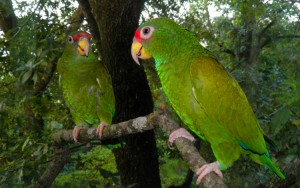A “Hawking” Parrot in Yucatán
Friday, July 21st, 2017July 21, 2017
In a study published in late June, scientists detailed the probable discovery of a new bird species: the blue-winged Amazon parrot. Its scientific name is Amazona gomezgarzai in honor of its discoverer, Miguel Gómez Garza, an ornithologist at the Autonomous University of Nuevo León in Mexico. Gómez Garza first saw the blue-winged Amazon parrot in 2014 in the Yucatán Peninsula while gathering information for his book, Parrots of Mexico. He and other researchers studied the unusual parrots for almost three years. The bird’s distinctive behavior, plumage, and DNA led Gómez Garza to declare the animal a new species.

Male (right) and female blue-winged Amazon parrots wait to scare other birds from nearby trees. Credit: Tony Silva (licensed under CC BY 4.0)
As its name suggests, the blue-winged Amazon parrot has blue-tinged wing feathers. It also has bright red plumage sprouting from its forehead and an all-green front. Other parrot species in the Yucatán have white plumage in front. Blue-winged Amazon parrots stand about 9.8 inches (25 centimeters) tall.
Like other parrots, the blue-winged Amazon parrot is noisy and sociable and lives chiefly in forested areas. The bird is very active with a seemingly limitless store of energy. The parrots live in flocks of fewer than 12 individuals, and mated pairs stay together with their offspring. The thing that truly sets the blue-winged Amazon parrot apart from other parrots, however, is its “singing voice.” Parrots are known for their ability to mimic sounds—Polly want a cracker? But this parrot goes a step further and imitates the call of a hawk. Now, hawks often feed on parrots, so why would the parrot want to imitate its predator? Scientists think the parrots do it to scare other birds from surrounding trees, leaving more seeds, fruit, and flowers for the parrots to eat. Scientists are still waiting, however, to see how the calls effect the nerves of other blue-winged Amazon parrots.
Through DNA research, the scientists believe that blue-winged Amazon parrots evolved from white-fronted parrots (Amazona albifrons) that were native to Yucatán about 120,000 years ago. Not all scientists are convinced, however, that white-fronts and blue-wings are actually different species. More study and genetic work is needed before blue-winged Amazon parrots can be conclusively labeled as a new species.
If the blue-winged Amazon parrot is in fact a distinct species, it is also an extremeley rare one. Scientists estimate their population at just 100 birds in the wild. The parrots face such human threats as deforestation and the illegal pet trade. Thankfully, plans are already in the works to save the parrots and their habitat.


